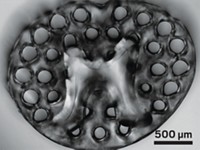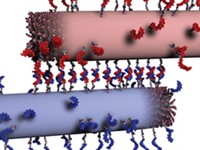Advertisement
Grab your lab coat. Let's get started
Welcome!
Welcome!
Create an account below to get 6 C&EN articles per month, receive newsletters and more - all free.
It seems this is your first time logging in online. Please enter the following information to continue.
As an ACS member you automatically get access to this site. All we need is few more details to create your reading experience.
Not you? Sign in with a different account.
Not you? Sign in with a different account.
ERROR 1
ERROR 1
ERROR 2
ERROR 2
ERROR 2
ERROR 2
ERROR 2
Password and Confirm password must match.
If you have an ACS member number, please enter it here so we can link this account to your membership. (optional)
ERROR 2
ACS values your privacy. By submitting your information, you are gaining access to C&EN and subscribing to our weekly newsletter. We use the information you provide to make your reading experience better, and we will never sell your data to third party members.

Roxanne Kieltyka
Supramolecular sage is developing polymeric scaffold materials for growing tissue in the lab
by Celia Arnaud
August 20, 2018 | APPEARED IN VOLUME 96, ISSUE 33
Roxanne Kieltyka first heard of supramolecular chemistry as an undergraduate studying inorganic chemistry, but she fell in love with it as a grad student.
It was then, she says, that she became captivated with the idea "that you can expeditiously make discrete structures and materials that show order, can be complex, and even be functional from self-assembling molecular precursors."
Supramolecular chemistry refers to assemblies of multiple molecules held together by noncovalent interactions. Those assemblies can have mechanical properties or bioactivity not seen in the individual components.
As a postdoc with E. W. (Bert) Meijer at Eindhoven University of Technology, Kieltyka turned her attention to the extracellular matrix in tissues and organs. This scaffolding supports cells and gives them physical and chemical cues to develop into tissue. Kieltyka wanted to use synthetic supramolecular polymers to make hydrogels as replacements for the extracellular matrix that scientists extract from mice for tissue engineering and cell cultures. She took a modular approach and found that she could make hydrogels with increased stiffness by mixing two weak ones.
In her own lab at Leiden University, Kieltyka continues to work with supramolecular materials. She makes hydrogel scaffolds for culturing induced pluripotent stem cells and plans to add chemical, biological, and environmental cues to guide them to differentiate into virtually any cell type of the human body.
"The natural extracellular matrix is the ultimate supramolecular biomaterial," Kieltyka says. She wants to mimic its ability to present the right biochemical and biophysical cues at the right place and the right time with supramolecular hydrogels.
The goal is to load the materials with cues to grow complex microtissues that can be used in applications such as drug screening. For example, a patient's own cells could be used to grow a diseased tissue to evaluate its response to potential drug treatments. These same materials could even be applied therapeutically, and she hopes to use them to deliver drugs in response to disease biomarkers or certain types of cells.
Her work is establishing design parameters that will guide others dreaming up their own supramolecular materials. John Matson, a supramolecular chemist at Virginia Tech, says: "She has a methodical approach that's helping to shape the field."
Watch Kieltyka speak at the American Chemical Society national meeting on Aug. 20 in Boston.
Vitals
Current affiliation: Leiden University
Age: 37
Ph.D. alma mater: McGill University
I've overcome adversity in the lab by: Once I knocked over a round-bottom flask in my fume hood containing a precursor that I needed to resynthesize a final molecule for a publication. There was not enough time to start again from the beginning, so after cleaning up the spill using paper towels, I extracted the compound from them and was able to obtain a sufficient amount to continue the synthesis after a second round of column chromatography.
If I were an element, I would be: Being a scientist, mentor, teacher, parent, and spouse, I think I would be carbon. It is a versatile element that is involved in multiple bonds simultaneously and can be found everywhere.
Latest TV show binge-watched: "Chef's Table"
Walk-up song: "(Far from) Home" by Tiga
Research at a glance

Credit: Yang H. Ku/C&EN/Shutterstock
Kieltyka is harnessing supramolecular structures to make hydrogel scaffolds for culturing stem cells. In the future, she plans to incorporate bioactive cues to direct the stem cells to grow into any kind of tissue she wants.
Three key papers
"Squaramide-Based Supramolecular Materials for Three-Dimensional Cell Culture of Human Induced Pluripotent Stem Cells and Their Derivatives"
(Biomacromolecules. 2018, DOI: 10.1021/acs.biomac.7b01614)
"Crosslinker-Induced Effects on the Gelation Pathway of a Low Molecular Weight Hydrogel"
(Adv. Mater. 2017, DOI: 10.1002/adma.201603769)
"Aromatic Gain in a Supramolecular Polymer"
(Angew. Chem. Int. Ed. 2015, DOI: 10.1002/anie.201503905)
Tissue Engineering
Roxanne Kieltyka
Supramolecular sage is developing polymeric scaffold materials for growing tissue in the lab
by Celia Henry Arnaud
August 19, 2018
| A version of this story appeared in
Volume 96, Issue 33


Vitals
Current affiliation: Leiden University
Age: 37
Ph.D. alma mater: McGill University
I’ve overcome adversity in the lab by: Once I knocked over a round-bottom flask in my fume hood containing a precursor that I needed to resynthesize a final molecule for a publication. There was not enough time to start again from the beginning, so after cleaning up the spill using paper towels, I extracted the compound from them and was able to obtain a sufficient amount to continue the synthesis after a second round of column chromatography.
If I were an element, I would be: Being a scientist, mentor, teacher, parent, and spouse, I think I would be carbon. It is a versatile element that is involved in multiple bonds simultaneously and can be found everywhere.
Latest TV show binge-watched: “Chef’s Table”
Walk-up song: “(Far from) Home” by Tiga
Three key papers
“Squaramide-Based Supramolecular Materials for Three-Dimensional Cell Culture of Human Induced Pluripotent Stem Cells and Their Derivatives” (Biomacromolecules 2018, DOI: 10.1021/acs.biomac.7b01614)
“Crosslinker-Induced Effects on the Gelation Pathway of a Low Molecular Weight Hydrogel” (Adv. Mater. 2017, DOI: 10.1002/adma.201603769)
“Aromatic Gain in a Supramolecular Polymer” (Angew. Chem. Int. Ed. 2015, DOI: 10.1002/anie.201503905)
Roxanne Kieltyka first heard of supramolecular chemistry as an undergraduate studying inorganic chemistry, but she fell in love with it as a grad student.
It was then, she says, that she became captivated with the idea “that you can expeditiously make discrete structures and materials that show order, can be complex, and even be functional from self-assembling molecular precursors.”
Supramolecular chemistry refers to assemblies of multiple molecules held together by noncovalent interactions. Those assemblies can have mechanical properties or bioactivity not seen in the individual components.
As a postdoc with E. W. (Bert) Meijer at Eindhoven University of Technology, Kieltyka turned her attention to the extracellular matrix in tissues and organs. This scaffolding supports cells and gives them physical and chemical cues to develop into tissue. Kieltyka wanted to use synthetic supramolecular polymers to make hydrogels as replacements for the extracellular matrix that scientists extract from mice for tissue engineering and cell cultures. She took a modular approach and found that she could make hydrogels with increased stiffness by mixing two weak ones.
In her own lab at Leiden University, Kieltyka continues to work with supramolecular materials. She makes hydrogel scaffolds for culturing induced pluripotent stem cells and plans to add chemical, biological, and environmental cues to guide them to differentiate into virtually any cell type of the human body.
“The natural extracellular matrix is the ultimate supramolecular biomaterial,” Kieltyka says. She wants to mimic its ability to present the right biochemical and biophysical cues at the right place and the right time with supramolecular hydrogels.
The goal is to load the materials with cues to grow complex microtissues that can be used in applications such as drug screening. For example, a patient’s own cells could be used to grow a diseased tissue to evaluate its response to potential drug treatments. These same materials could even be applied therapeutically, and she hopes to use them to deliver drugs in response to disease biomarkers or certain types of cells.
Her work is establishing design parameters that will guide others dreaming up their own supramolecular materials. John Matson, a supramolecular chemist at Virginia Tech, says: “She has a methodical approach that’s helping to shape the field.”




















Join the conversation
Contact the reporter
Submit a Letter to the Editor for publication
Engage with us on Twitter